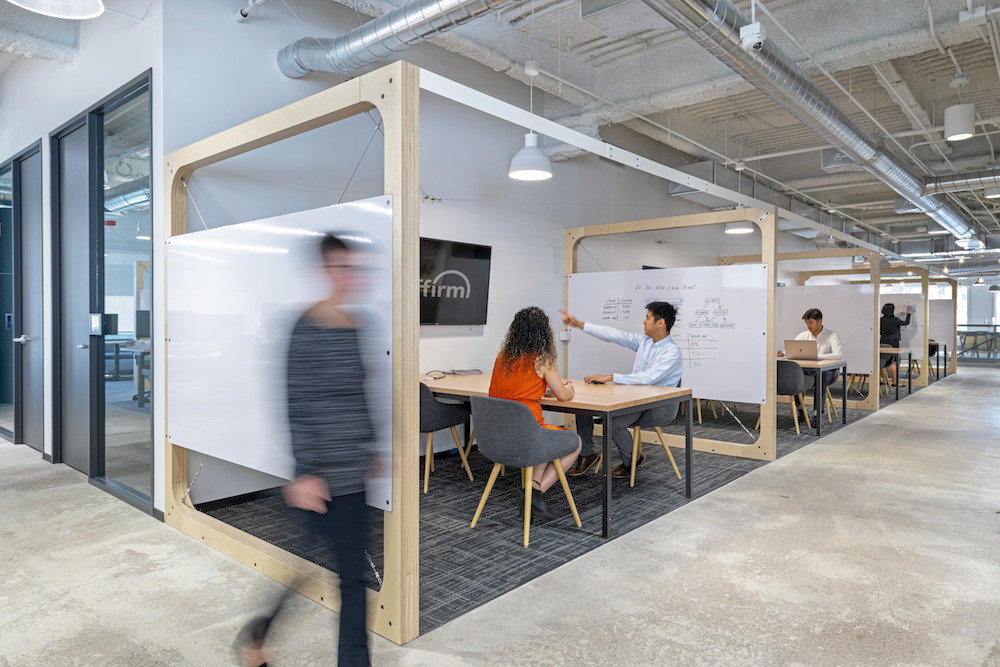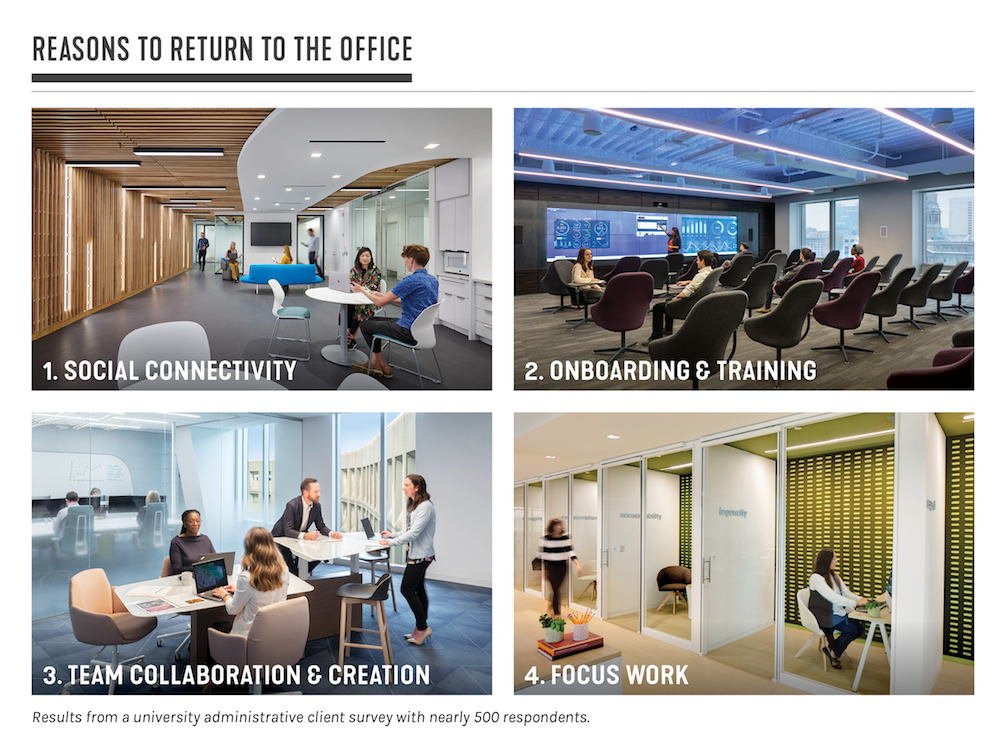Design alone is not enough to move the needle in the post-COVID-19 workplace. SmithGroup’s Lise Newman explores how a robust change management program running parallel to the design process is critical for success.

Implementing workplace transformation is one of the most impactful organizational initiatives any company will undertake. Leveraging the design of its workplace to align with its culture and vision for organizational improvement can yield significant return on investment. With up to 90 percent of a company’s expenses identified as human capital costs in the way of salaries and benefits, the design of the workplace environment can positively impact talent attraction, engagement, retention, wellbeing, and an organization’s ability to innovate. But…. workplace design alone is not enough to move the needle. A robust change management program running parallel to the design process is critical for success. In normal times, effectively managing a change initiative is difficult, and organizations fall short roughly 75 percent of the time, according to BCG Henderson Institute.
The first half of 2020 was anything but normal. At the onset of the COVID-19 pandemic in March, companies had very little time to adapt to operating with a remote workforce. Half a year later, with third quarter financials and staff surveys as proof, many in the C-suite acknowledge that not only have corporate expenses been significantly reduced, but that remote work has been effective for many divisions within their companies. Equally impactful, employees are reporting higher levels of satisfaction as the result of the flexibility and work-life balance that remote work affords. This trifecta of reduced expenses, increased productivity and enhanced employee satisfaction is leading to a paradigm shift in real estate. Organizational and cultural change are the driving factors in the physical transformation of workspace. Using an experience-based process, SmithGroup’s workplace strategists have engaged leadership, managers, and staff to collectively define a holistic model for workplace transformation that reinforces the unique culture, brand and mission of the companies with which we work.

Recognizing that there is no “one size fits all” approach for workplace transformation, we have found this four-step engagement process is critical to an effective change management program. The effort commences with an in-depth discovery phase whereby leadership provides insight on organizational threats (real and perceived) as well as opportunities for organizational advancement in a post-pandemic world. This phase is then followed by fact-finding interviews with an array of leaders to better understand operational needs and capacity for specific divisions to successfully work remotely regardless of the current COVID-19 scenario. These findings are triangulated with staff input via a general survey, delivering a company-specific awareness of enablers and inhibitors for remote work, as well as what types of activities would ideally occur within the transformed workplace. Once the stage for success has been established, physical space improvements that align with organizational drivers are explored in collaboration with HR, IT and CRE leaders to define policy and guidelines for working in the transformed spaces.
Organizational and cultural change are the driving factors in the physical transformation of workspace.
While the first three steps in this holistic engagement process are essential to defining the right problem(s) that may inhibit a company’s future success, perhaps the most important component of the process is the fourth step: managing the transition to a transformed workplace that supports both remote and in-office teams. In working with corporate, institutional, and federal clients since the onset of the COVID-19 pandemic, some consistent themes have emerged for a successful change management program.
Frequent and consistent communication from leadership is more important than ever.
Employees seek a greater degree of transparency and assurance on the overall health of the organization and plans for the company’s future in uncertain times. Numerous employee survey responses across multiple organizations and regions of the country indicate that communication from leadership has declined during the pandemic. If anything, employees are looking for more frequent communication from company leadership than ever before, not only regarding financial stability but also regarding return to work plans, workplace design modifications. Employee survey responses also indicate that issues such as cleanliness and hygiene in the workplace and emotional wellbeing are top priorities as staff contemplate returning to the office. Feedback from surveys confirm that messages regarding these issues could have been improved and better communicated to staff. Clearly, leadership has a great opportunity to become more personable and approachable in their dialogue with staff – acknowledging that they understand the vast array of challenges employees face upon returning to the office. As a result, leaders must delineate a visionary path forward – one that balances employee choice with an appropriate degree of in-office presence to maintain a strong organizational culture.
Create messaging that connects workplace design changes to the discovery process findings.
Messaging that aligns with organizational opportunities and business drivers established during the discovery phase – and which also responds to the human and social factors identified in the survey – will result in greater buy-in from employees. The more overtly workplace design modifications can be linked to these drivers and direct employee input, the more successful the transition back to the office will be. Messaging that correlates specific design changes to “why” employees want to come into to a physical office will be appreciated and better understood. Consider creating messaging that integrates a graphic snip from a relevant survey, interview or workshop findings, alongside proposed design solutions.

Specific training for managers to effectively manage a remote workforce is required.
While staff in most organizations have adjusted to working remotely, managers continue to report that they are uncertain of how best to manage teams when leadership and employees no longer sit side-by-side. Managing a blended workforce in which some of the team may be in the office several days a week while others are remote requires additional skills and different performance indicators to ensure that teams are not only effective, but are engaged and connected to the organization. Equally important, equity for teams split between remote and in-office environments requires technology to enable both remote and in-office teams to be on par, as well as a shift in managerial mindsets that measure results regardless of physical presence.
Manager training can also include awareness of the subtle signs that employees may be using to express isolation and/or dis-engagement. These cues are more difficult to pick up when cameras are turned off and primary communication takes place by way of scheduled meetings as opposed to informal walks around the office, impromptu coffee breaks or meals together – as might often have been the case in a pre-pandemic workplace.
Leverage this time of uncertainty to advance innovation and improve as an organization.
While many building initiatives are on pause, thoughtful conversations and discovery processes that engage C-suite leaders, managers and staff can lead to future success. SmithGroup’s strategists and designers are facilitating conversations with cross-sectional leaders across organizations to explore how each company can emerge from this unprecedented global disruption as a stronger entity. By exploring future threats facing each organization, identifying other potential challenges, and capitalizing on unexpected positive operational improvements that have emerged out of the mandated work-from-home experiment, more and more companies are recognizing that the COVID-19 pandemic is an inflection point. An impetus for modifying workspace, this global crisis may ultimately positively impact organizations and provide the opportunity to improve operations. As an example, one company cited their workplace transformation initiative as the opportunity to enhance operational excellence through technology, create intentionality around team building, integrate flexibility in the workplace (in anticipation of the need to be resilient in the future) and define a new mindset around shared vs. individually-owned space. All of these business-driven goals have implications for physical workspace transformation and sharing these opportunities with employees can enhance buy-in for workplace design modifications.

Flexibility and adaptability are key.
Perhaps the most important element for a successful workplace change management program today hinges on the realization that while we can quantify a seat count based on analysis of remote work effectiveness, we simply don’t know what employees and companies will need just a few years from now. If the last few months have taught us anything, it is to expect the unexpected and integrate adaptable, agile and flexible solutions into any workplace design. Implementing a pilot program ahead of a larger transformation, creating workplace design that is more universal vs. bespoke, allowing different groups to use similar spaces as needs evolve, and minimizing hard-wall architectural monuments are a few maneuvers to consider as we enter the uncharted territory of creating the next successful model for the future workplace. The evolution of the workplace over the last fifty years—from predominately enclosed office environments, to the open office filled with rows of cubicles, to benching and ultimately the activity-based environment that we left a few months ago—is likely to shift once again. Reimaging the future of work will require integrating an iterative framework in which employee feedback continuously informs workplace design solutions. Guiding organizations through this maze of transformational change with an interactive and engaging process will be more important than ever.

